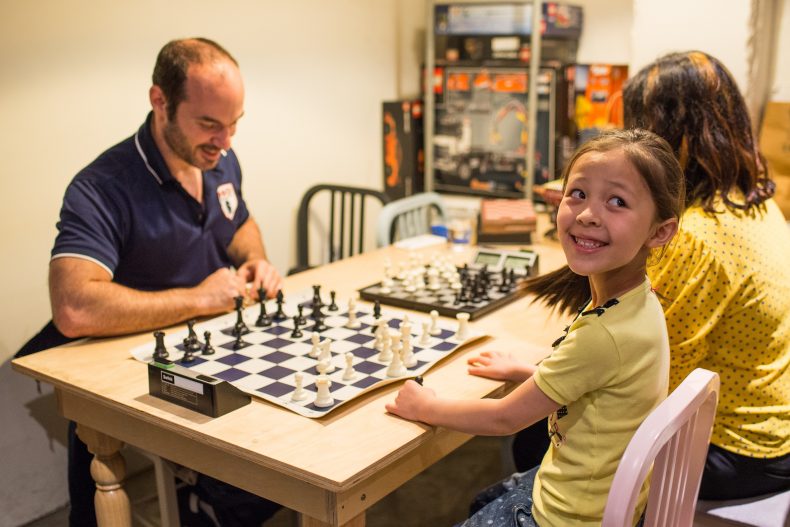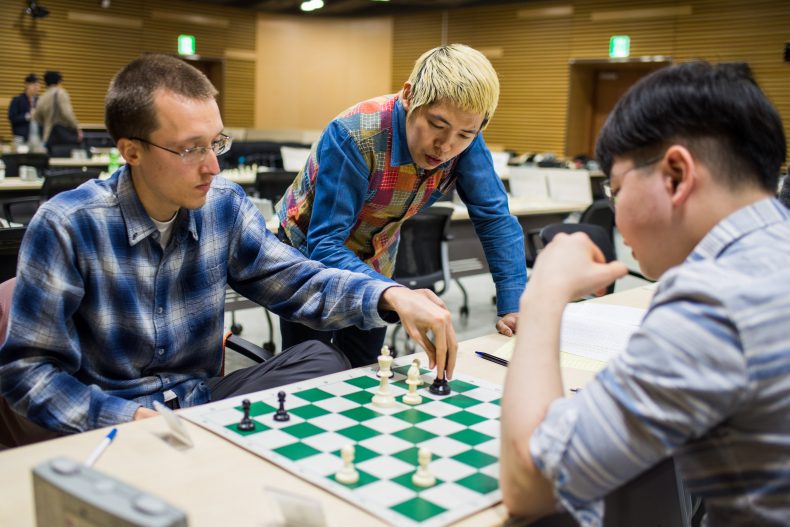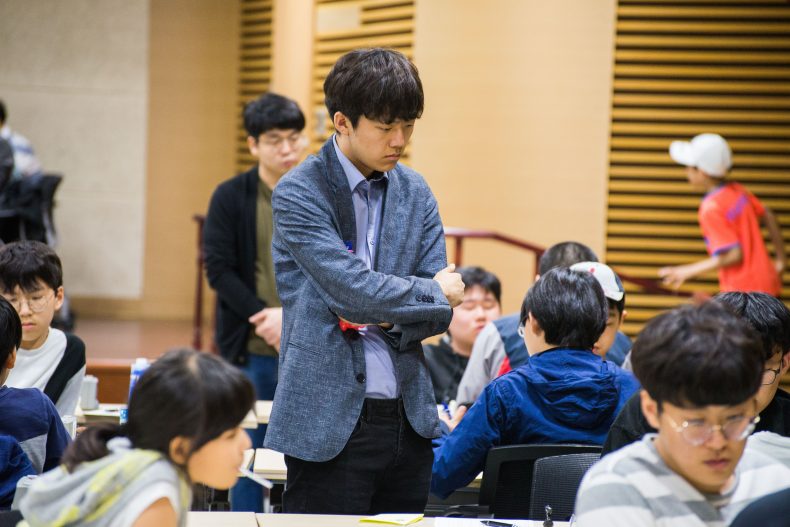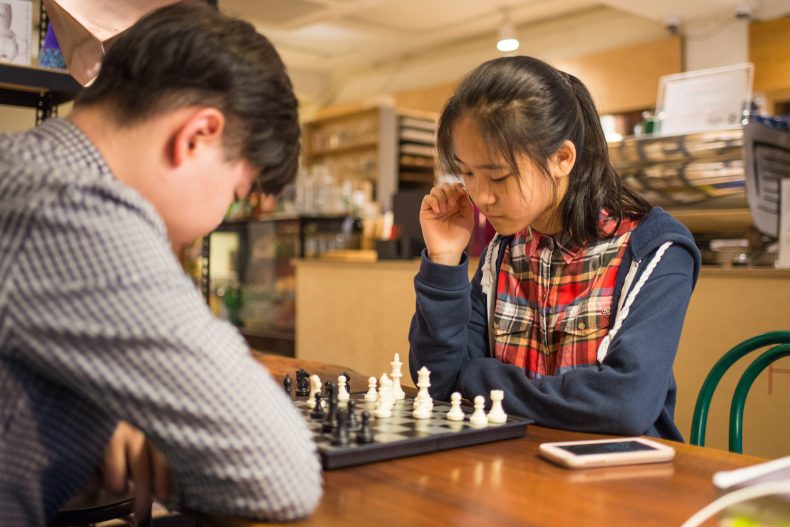Alina Shim has to sit in a chair on her knees so she can see the chessboard. Just 6 years old, she pores over the position before making her move, then turns toward her mother and beams a smile as bright as her dandelion yellow shirt.
She’s playing a blitz game at a mid-April chess meetup in a Gangnam cafe and has only a few minutes to make her moves. With her right hand, she develops her knight to control the center, pins a piece with her bishop, swings a rook along the first rank. With her left hand, she fiddles with a captured pawn.
In the end, she concedes, outmatched by visiting American chess master Greg Shahade. But when he starts to point out his next moves, she takes the pieces and plays out the game herself, having already calculated her opponent’s winning sequence.
Shim is one of the most promising chess players in South Korea. But while her prodigy-like talent sets her apart, she is by no means alone in her enthusiasm for the game — or in her youth.
“The thing that’s unique about the Korean chess scene is that young kids are the strongest players,” said Yang Hyunseung, who plays in a local chess league. “It’s kinda inverted because we have no established strong masters. So everyone’s pretty good, but then the kids are the best.”
That youthfulness bodes well for the future of chess in a country where the game has long been overshadowed by baduk, also known as Go.
Yet the lack of strong masters means South Korea lags far behind in international rankings, currently sitting outside the top 100 countries according to the World Chess Federation (FIDE).
South Korean chess has grown from almost nothing into a thriving subculture over the past decade. Now can it break through internationally?

Six-year-old Alina Shima beams a smile at her mother while playing against American chess master Greg Shahade at a Gangnam cafe on April 20, 2018. Photo by Bryan Betts.
K-League
A few weeks after her game against Shahade, Shim and 140 or so other players gathered at a conference center south of Seoul for the final round of K-League’s 2018 spring season. The league is the only one in South Korea and features a higher level of play than local tournaments.
Participants from as far away as the southeastern city of Busan, about five hours by car, were still finding their seats as an arbiter announced the start of the first game at 9:30 a.m. The players shook hands and made their opening moves, dutifully recording the action on their scoresheets.
After that, the lecture hall went quiet. Competitors settled into their go-to thinking poses — elbows on knees, chin in palm, hands folded as in prayer — repositioning every few minutes. The only sounds were the occasional shuffling of chairs, clinking of pieces, and clicking of game clocks.
Every so often, a hand went up and Lee Sanghoon, an arbiter easily identified by his dyed blonde hair, would walk over to cross-check scoresheets and sign off on the results.
Lee has witnessed firsthand how far K-League has come as one of six pioneering players who helped start the league in 2008. Back then, competitive chess was in its infancy — he and a few others became the first Koreans to get FIDE ratings just two years earlier — and the goal was to attract new players and professionalize the game.
For Lee, blazing a trail as a chess professional meant forsaking a career with his father’s interior design firm for an uncertain future.
“It was like banging my head against hard ground,” he said of his early struggles to make a living.
But Lee and others kept competing, overseas as well as in K-League, gradually improving their ratings and winning titles. With success came teaching and coaching opportunities that enabled them to make viable careers out of chess.

K-League official Lee Sanghoon (C) analyzes a position with Thomas Goller (L) and Luke Robson (R) after their K-League chess game on April 1, 2018. Photo by Bryan Betts.
In time, the Korea Chess Federation (KCF), formed in 2008, and other organizations began training instructors. KCF official Kang Hyo-seok estimated that there are now as many as 400 chess instructors in South Korea, with the most successful able to teach hundreds of students and make as much as a 10-year employee of a corporation or bank.
Perhaps the best confirmation of South Korea’s increasing competitiveness in chess would be a homegrown player with an international title — specifically International Master or Grandmaster. The top-ranked Lee Jun-hyeok has arguably the best shot at becoming his country’s first.
The 18-year-old Lee, a FIDE Master, said he has been playing chess since 2010, initially learning with the help of YouTube videos that analyzed master’s games. Now a college freshman, he plans to continue competing abroad during school breaks in pursuit of an international title.
“To be honest I think he’s virtually International Master strength already,” said Martin Walker, a British FIDE Master living in South Korea. “His understanding of the game is far beyond what mine was when I was 18. And when you bear in mind that he’s had to grow up in a country with almost no chess infrastructure, that really is an outstanding achievement.”

Top-ranked South Korean chess player Lee Jun-hyeok, who could become the country’s first International Master, watches a game during the final round of the K-League’s spring season on May 13, 2018. Photo by Bryan Betts.
Mind Games
Elementary and middle school students predominate in the lower divisions of K-League. During the last round of the spring season, many displayed surprising patience and concentration for their age, locked in what could be hours-long games. A few squirmed in their seats, whipped off quick moves with little thought, and wandered around watching friends play.
Regardless, their parents seemed eager to support them in a hobby that encourages studiousness and critical thinking.
“For me, that’s the main point to play chess, because I think it’s quite educational,” said Igor Barvoski, the father of 10-year-old Division 3 player Yuri Barkovski. “To achieve something in chess, it’s a very similar method for achieving something somewhere else: study and check your current level, compete and study.”
There’s precedent in South Korea for such an academic approach to board games. Schools that teach baduk, a game far more complicated than chess, are common. Would-be professionals forgo a traditional education to study the game from early childhood, with several South Koreans among the world’s top players.
Baduk’s popularity may partially explain why chess isn’t widely played in South Korea. But it’s also true that the two games can reinforce one another.
That’s more or less the operating philosophy of Lee Seong-geun, who founded the Modern Baduk and Chess Academy in Hanam in 2000. Students typically attend his academy two to three times a week and study both games.
“You can improve your chess skills in a short amount of time very quickly, whereas baduk takes a really long time to improve,” said Lee, who has also given chess lectures on a baduk television channel. “So I thought that would also be attractive to people who want to play the game … It’s beneficial to have knowledge of both games and learn them together.”

Kim Yu-bin (R) faces off against Luke Robson (L) in a casual game during a chess meetup at a Gangnam cafe on April 20, 2018. Photo by Bryan Betts.
Global Reach
When she first got into chess nine years ago, K-League Division 1 player Kim Yu-bin would find opportunities to play whenever she could, even if that meant rotating the chessboard to play against herself.
That hasn’t been necessary in the years since as she’s traveled around the world — to Slovenia, Norway, Azerbaijan, the UAE — to face off against top talent. Soon, the second-year middle schooler will go abroad again to compete on the South Korean team at the upcoming Chess Olympiad in Batumi, Georgia.
Her experience highlights an important aspect of chess’ appeal — it’s international. Unlike baduk, which is mostly played in East Asia, chess is played in almost every country of the world, with FIDE listing 189 member federations.
The game’s reach means the best players can use their chess experience to angle for admission or scholarships at overseas universities, instructors said. Playing at tournaments abroad also provides opportunities for cultural exchange.
In Kim’s case, interacting with competitors has helped her improve her English conversation ability, a highly regarded skill here.
South Korea, however, lacks international tournaments that draw players from overseas. One side effect is that most Korean players don’t have the chance to win rating points by playing against foreign competition.
“That’s why when Korean players go to other countries to play, they tend to play higher than their rating,” said Division 1 player Luke Robson. “Because here everything gets deflated because we’re all playing each other.”
K-League, at least, has an international feel, with players from Russia, Mongolia, the United Kingdom, and the United States, among other countries.
Six-year-old Shim reflects the league’s diversity as a child who’s half-Korean and recently moved from Russia. For now, though, she’ll be maintaining her membership in the Russian Chess Federation, her mom said, since the chess superpower has more resources to support players.
Still, playing against an International Master like Shahade was an opportunity she never had while living in a small town near Vladivostok in the Russian Far East.
Shim and her mom thanked Shahade for the game as they left the Gangnam meetup. He gave a vote of confidence that spoke to her potential — and perhaps also that of Korean chess.
“Next time I see her, she’ll be a Grandmaster,” he said.
Haeju Kang contributed reporting to this story.
Bryan Betts is a freelance journalist based in Seoul. He has worked for daily newspapers in South Carolina and New Mexico and previously taught English in South Korea through the U.S. Fulbright Program.

































